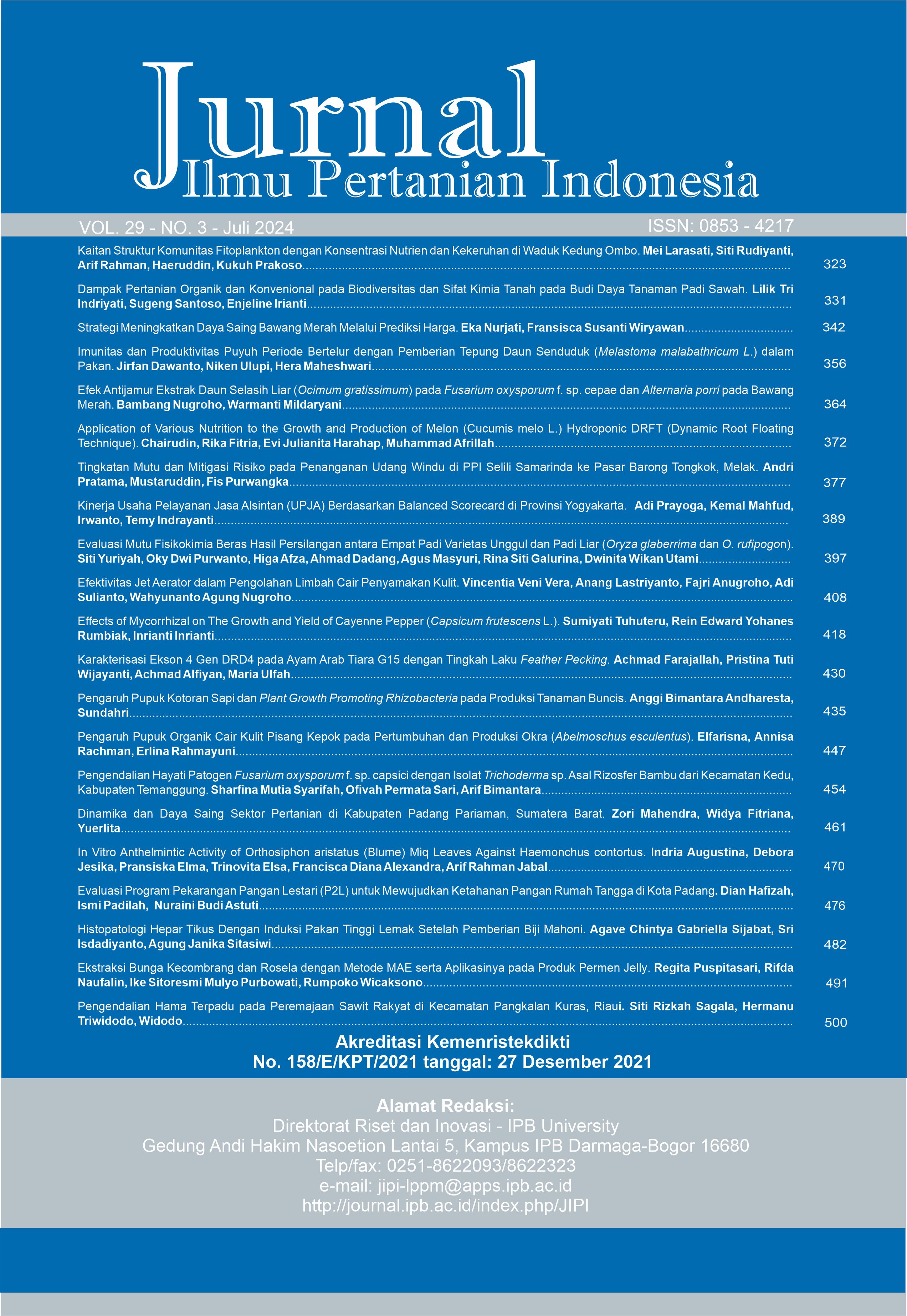Tingkatan Mutu dan Mitigasi Risiko pada Penanganan Udang Windu di PPI Selili Samarinda ke Pasar Barong Tongkok, Melak
Abstract
East Kalimantan has a superior commodity: tiger shrimp (Penaeus monodon). Some of these commodities are marketed to several areas in Samarinda City and to areas outside Samarinda City, namely West Kutai Regency (Barong Tongkok Market). The distribution process uses a cold chain (cool box) system for 12 hours of travel. Long distribution times cause product quality to decrease. This study aims to assess tiger shrimp's quality and handling strategies using a cold chain system at PPI Selili Samarinda City. The quality level is determined using organoleptic testing at points 1 (PPI Selili) and 2 (Pasar Barong Tongkok). The formal safety assessment (FSA) method is used to identify risks in each handling activity, risk assessment associated with tiger shrimp deterioration, risk control, and recommendations to minimize quality degradation. Based on organoleptic tests, the quality of tiger shrimp is included in the category of safe for consumption. Product handling activities included unloading products from ships, moving them to terminals, washing, structuring, packaging in cool boxes, transportation by shipping services, shipping to Melak Pasar Barong Tongkok, unloading from shipping services, and product arrangement. The highest potential risk is handling shipments to Melak Pasar Barong Tongkok, which has 22 potential hazards. Risk mitigation can be applied through socialization and evaluation related to suitable fish handling methods (CPIB) and making operational schedules for cleaning in the product loading and unloading area before and after handling activities.
Keywords: formal safety assessment, risk management, handling strategy, transportation, tiger shrimp
Downloads
References
BS] OHSAS 18001. 2007. Occupational Health and Safety Management Systems: Requirements. London (UK): British Standard Institution.
[BSN] Badan Standarisasi Nasional. 2006. SNI 2346:2006, Petunjuk Pengujian Organoleptikdan atau Sensori pada Produk Perikanan. Jakarta (ID): BSN.
Arsyad AG, Ferdinant PF, Ekawati R. 2017. Analisis Peta Kendali p yang Distandarisasi dalam Proses Produksi Regulator Set Fujiyama (Studi Kasus: PT XYZ). Jurnal Teknik Industri. 5(1): 86–92.
Giatsis C, Sipkema D, Smidt H, Heilig H, Benvenuti G, Verreth J, Verdegem M. 2015. The impact of rearing environment on the development of gut microbiota in tilapia larvae. Scientific Report 5: 1–15. https://doi.org/10.1038/srep18206
Han JW, Li QX, Wu HR, Zhu HJ, Song YL. 2019. Prediction of cooling efficiency of forced air precooling systems based on optimized differential evolution and improved BP neural network. Application Soft Computer Journal. 84: 105733. https://doi.org/10.1016/j.asoc.2019.105733
Han JW, Zuo M, Zhu WY, Zuo JH, Lü EL, Yang XT. 2021. A comprehensive review of cold chain logistics for fresh agricultural products: Current status, challenges, and future trends. Trends Food Science Technology 109: 536–551. https://doi.org/10.1016/j.tifs.2021.01.066
Haworth N, Hughes S. 2012. The International Labour Organization. Handbook of Institutional Approaches to International Bussines. https://doi.org/10.4337/9781849807692.00014
Kristikareni RD, Rokhman A, Poernomo A. 2020. Analisis jaminan mutu dan keamanan pangan sepanjang rantai pasok udang budidaya (analysis of quality and safety assurance along the supply chain of cultured shrimp). Jurnal Kebijakan Perikanan Indonesia. 12(1): 23. https://doi.org/10.15578/jkpi.12.1.2020.23-33
Litaay C, Wisudo SH, Arfah H. 2020. Penanganan ikan cakalang oleh nelayan pole and line. Jurnal Pengolahan Hasil Perikanan Indonesia. 23(1): 112–121. https://doi.org/10.17844/jphpi.v23i1.30924
Mustaruddin M, Santoso J, Baskoro M. 2016. The handling system of product and existence of waste components in fishing operation of tuna in Bitung, North Sulawesi. Jurnal Pengolahan Hasil Perikanan Indonesia. 19(1): 58–68. https://doi.org/10.17844/jphpi.2019.19.1.58
Ouadi. 2011. Post harvest fish loss assessment in small scale fisheries: A guide for the extension officer. In Fao Fisheries and Aquaculture Technical Paper (Vol. 559). FAO Fisheries and Aquaculture Technical Paper. http://www.fao.org/3/i2241e/i2241e.pdf
Pandit IGS. 2022. Teknologi tepat guna penanganan udang windu segar dengan menggunakan suhu rendah. Ed ke-1 Husein M, editor. Yogyakarta (ID): KBM Indonesia.
Sakina NS, Purwangka F, Mustaruddin. 2022. Prioritas risiko penanganan dan transportasi ikan tuna di Pelabuhan Perikanan Pantai (PPP) Pondokdadap. ALBACORE Jurnal Penelitian Perikanan Laut. 5(2): 147–160. https://doi.org/10.29244/core.5.2.147-160
Saraswati E, Purwangka F, Mustaruddin, Darmawan. 2022. Analisis Risiko Penurunan Mutu Ikan Lemuru Selama Aktivitas Penanganan di UD. Duta Quraesy, Jember. ALBACORE Jurnal Penelitian Perikanan Laut. 6(2): 111–122. https://doi.org/10.29244/core.6.2.111-122
Sari N, Lubis E, Nugroho T, Muninggar R. 2020. Improve handling of fish caught in the Indonesian fishing port of Palabuhanratu (PPN) Palabuhanratu. Jurnal Pusat Inovasi Masyarakat. 2(1): 80–84.
Tanasale MFJDP, Telussa I, Sekewael SJ, Kakerissa L. 2016. Extraction and characterization of chitosan from windu shrimp shell (Penaeus monodon) and depolymerization chitosan process with hydrogen peroxide based on heating temperature varations. Indonesian Journal of Chemical Research 3(2): 308–316.
Webster UTM, Consuegra S, Hitchings M, Garcia de Leaniz C. 2018. Interpopulation variation in the Atlantic salmon microbiome reflects environmental and genetic diversity. Applied and Environmental Microbiology. 84(16): e00691–18. https://doi.org/10.1128/AEM.00691-18
Wahab HS, Gunawan BI. 2023. The evaluation of supporting capability and development strategy of selili fish landing base, Samarinda City. Agrikan Jurnal Agribisnis Perikanan. 16(2): 144–156.doi:https://doi.org/10.52046/agrikan.v16i2.144-156.
Wu S, Wang G, Angert ER, Wang W, Li W, Zou H. 2012. Composition, diversity, and origin of the bacterial community in grass carp intestine. PLoS One. 7(2). https://doi.org/10.1371/journal.pone.0030440
Copyright (c) 2024 Mustaruddin Mustaruddin

This work is licensed under a Creative Commons Attribution-NonCommercial 4.0 International License.
This journal is published under the terms of the Creative Commons Attribution-NonCommercial 4.0 International License. Authors who publish with this journal agree to the following terms: Authors retain copyright and grant the journal right of first publication with the work simultaneously licensed under a Creative Commons Attribution-NonCommercial 4.0 International License. Attribution — You must give appropriate credit, provide a link to the license, and indicate if changes were made. You may do so in any reasonable manner, but not in any way that suggests the licensor endorses you or your use. NonCommercial — You may not use the material for commercial purposes.























